
The Gibson SG is a solid-body electric guitar model introduced by Gibson in 1961 as the Gibson Les Paul SG. It remains in production today in many variations of the initial design. The SG Standard is Gibson's best-selling model of all time.
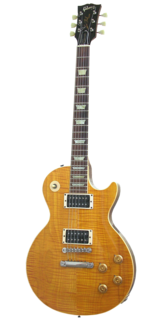
The Gibson Les Paul is a solid body electric guitar that was first sold by the Gibson Guitar Corporation in 1952. The Les Paul was designed by Gibson president Ted McCarty, factory manager John Huis and their team with input from and endorsement by guitarist Les Paul. Its typical design features a solid mahogany body with a carved maple top and a single cutaway, a mahogany set-in neck with a rosewood fretboard, two pickups with independent volume and tone controls, and a stoptail bridge, although variants exist.

The Gibson ES-335 is the world's first commercial semi-hollowbody electric guitar, sometimes known as semi-acoustic. Released by the Gibson Guitar Corporation as part of its ES series in 1958, it is neither fully hollow nor fully solid; instead, a solid maple wood block runs through the center of its body. The side "wings" formed by the two "cutaways" into its upper bouts are hollow, and the top has two violin-style f-holes over the hollow chambers. Since its release, Gibson has released numerous variations of and other models based on the design of the ES-335.
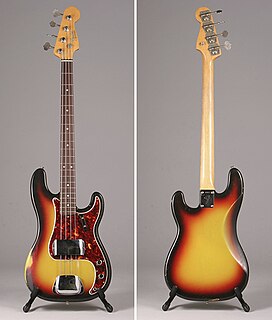
The Fender Precision Bass is a model of electric bass manufactured by Fender Musical Instruments Corporation. In its standard, post-1957 configuration, the Precision Bass is a solid body, four-stringed instrument equipped with a single split-coil humbucking pickup and a one-piece, 20-fret maple neck with rosewood or maple fingerboard.
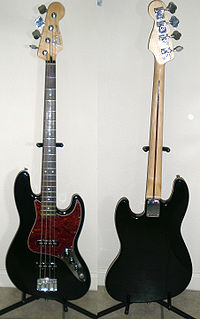
The Fender Jazz Bass is the second model of electric bass created by Leo Fender. It is distinct from the Precision Bass in that its tone is brighter and richer in the midrange and treble with less emphasis on the fundamental frequency. The body shape is also different from the Precision Bass, in that the Precision Bass has a symmetrical lower bout on the body, designed after the Telecaster and Stratocaster lines of guitars, while the Jazz Bass has an offset lower bout, mimicking the design aesthetic of the Jaguar and Jazzmaster guitars.
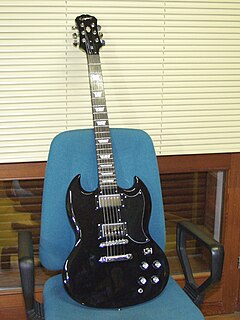
The G-400 is an Epiphone solid body electric guitar model produced as a more modestly priced version of the famous Gibson SG. Currently, Epiphone is a subsidiary of Gibson and manufactures the G-400 and other budget models at a lower cost in Asia. Visually and ergonomically, it is almost identical to a 1962 SG.
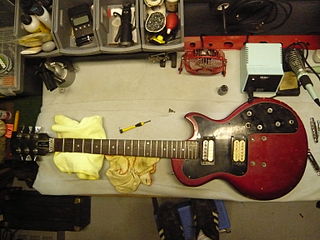
The Sonex guitars were a range of Gibson electric guitars launched in 1980. They were made from a synthetic material called Resonwood, and manufactured with Multi-phonic body construction. There were four models: Deluxe, Standard, Custom and Artist.

The Fender Jaguar Bass is an electric bass guitar manufactured in Japan and China by the Fender Musical Instruments Corporation.
A solid-body musical instrument is a string instrument such as a guitar, bass or violin built without its normal sound box and relying on an electromagnetic pickup system to directly detect the vibrations of the strings; these instruments are usually plugged into an instrument amplifier and loudspeaker to be heard. Solid-body instruments are preferred in situations where acoustic feedback may otherwise be a problem and are inherently both less expensive to build and more rugged than acoustic electric instruments.

The Gibson ES-135 is a semi-hollow body electric guitar made by the Gibson Guitar Corporation. Originally introduced in 1956, it was discontinued in 1958. The model, with some modifications, was reintroduced in 1991 and remained in production until 2004.
The ESP EX is a series of electric guitars produced by ESP produced in the United States, Europe and in Japan with the ESP logo as part of the ESP Original Series.
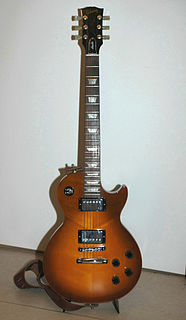
The Gibson Les Paul Studio is a solid body electric guitar produced by the Gibson Guitar Corporation since 1983.

The Gibson L6-S is a solid body electric guitar. It was the working musician's descendant of the L5S jazz solid-body electric guitar. It was the same shape, very much like a wide Gibson Les Paul, but with a 24-fret two-octave neck, the first Gibson guitar to have this.
The Gibson Les Paul bass is a bass guitar first manufactured by Gibson in 1969, just after the relaunch of the Les Paul guitar in 1968.

Epiphone Genesis refers to three Genesis Series models ever produced
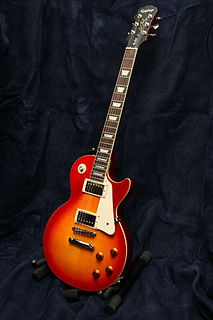
The Epiphone Les Paul is a solid body guitar line produced by Epiphone as a more modestly priced version of the famous Gibson Les Paul. Epiphone is a subsidiary of Gibson Guitar Corporation and manufactures the Les Paul model and other budget models at a lower cost in Asia.

The Gretsch 6128 is a chambered solid body electric guitar manufactured by Gretsch since the mid-1950s.

The Washburn N4 is an electric guitar model, developed in collaboration between Nuno Bettencourt, Washburn and the Seattle-based luthier Stephen Davies. Since its introduction in mid-late 1990, it became Bettencourt's primary guitar and it is marketed by Washburn as his signature model. The N4 is the flagship of the Washburn N-prefix guitar models.

The Epiphone Les Paul 100 (LP-100) is a solid body electric guitar first produced in 1993 and is based on the Gibson Les Paul. This budget priced, Gibson-authorized version of the Les Paul model, originally introduced with a carved maple top by Jim "Epi" Rosenberg at NAMM 1993, is made as a guitar with beginner and value minded consumers in mind. The Les Paul 100 is outwardly very similar to the original Les Pauls. It has a traditionally shaped, single cut mahogany body, thinner than most Les Paul models, with two tone controls, two volume controls and the three position Rhythm/Treble switch. It also sports a stopbar tailpiece and Tune-o-matic bridge, like the higher end models.
The Fender Telecaster, colloquially known as the Tele, is the world's first commercially successful solid-body electric guitar. Its simple yet effective design and revolutionary sound broke ground and set trends in electric guitar manufacturing and popular music. Introduced for national distribution as the Broadcaster in the autumn of 1950 as a two-pickup version of its sister model, the single-pickup Esquire, the pair were the first guitars of their kind manufactured on a substantial scale. A trademark conflict with a rival manufacturer's led to the guitar being renamed in 1951. Initially, the Broadcaster name was simply cut off of the labels placed on the guitars and later in 1951, the final name of Telecaster was applied to the guitar. The Telecaster quickly became a popular model, and has remained in continuous production since its first incarnation.
















